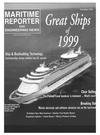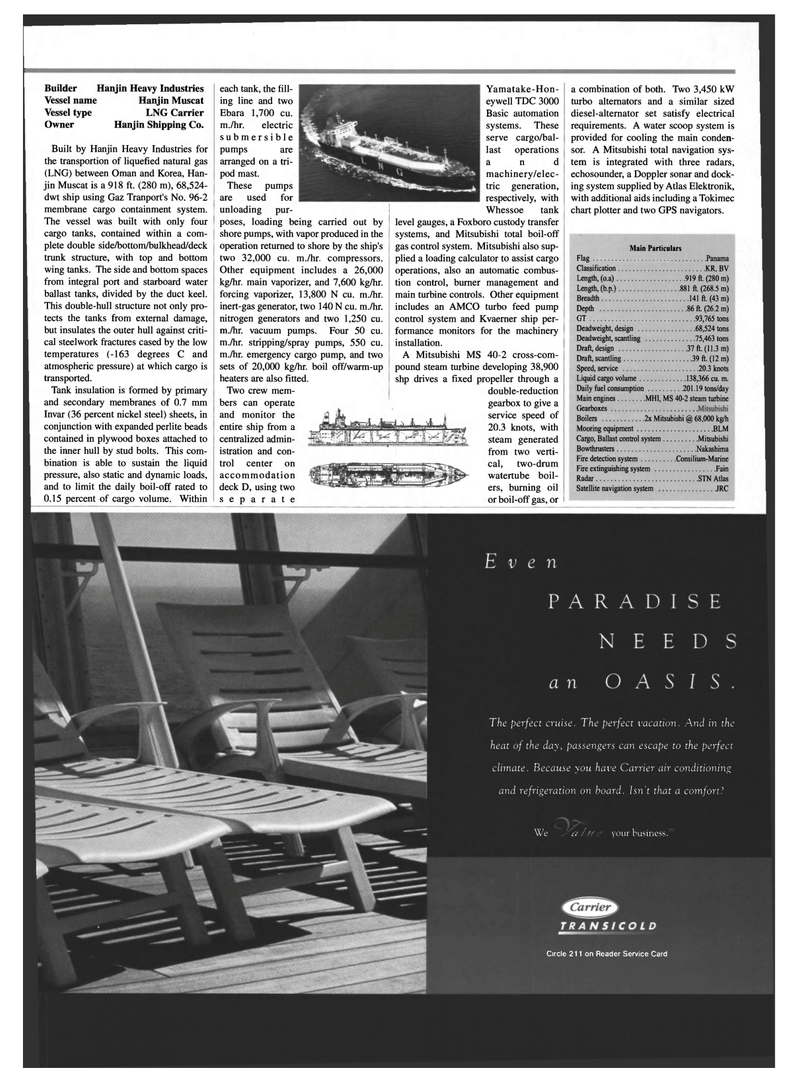
Page 37: of Maritime Reporter Magazine (December 1999)
Read this page in Pdf, Flash or Html5 edition of December 1999 Maritime Reporter Magazine
Builder Hanjin Heavy Industries
Vessel name Hanjin Muscat
Vessel type LNG Carrier
Owner Hanjin Shipping Co.
Built by Hanjin Heavy Industries for the transportion of liquefied natural gas (LNG) between Oman and Korea, Han- jin Muscat is a 918 ft. (280 m), 68,524- dwt ship using Gaz Tranport's No. 96-2 membrane cargo containment system.
The vessel was built with only four cargo tanks, contained within a com- plete double side/bottom/bulkhead/deck trunk structure, with top and bottom wing tanks. The side and bottom spaces from integral port and starboard water ballast tanks, divided by the duct keel.
This double-hull structure not only pro- tects the tanks from external damage, but insulates the outer hull against criti- cal steelwork fractures cased by the low temperatures (-163 degrees C and atmospheric pressure) at which cargo is transported.
Tank insulation is formed by primary and secondary membranes of 0.7 mm
Invar (36 percent nickel steel) sheets, in conjunction with expanded perlite beads contained in plywood boxes attached to the inner hull by stud bolts. This com- bination is able to sustain the liquid pressure, also static and dynamic loads, and to limit the daily boil-off rated to 0.15 percent of cargo volume. Within a combination of both. Two 3,450 kW turbo alternators and a similar sized diesel-alternator set satisfy electrical requirements. A water scoop system is provided for cooling the main conden- sor. A Mitsubishi total navigation sys- tem is integrated with three radars, echosounder, a Doppler sonar and dock- ing system supplied by Atlas Elektronik, with additional aids including a Tokimec chart plotter and two GPS navigators.
Main Particulars
Flag Panama
Classification KR, BV
Length, (o.a) 919 ft. (280 m)
Length, (b.p.) .. .881 ft. (268.5 m)
Breadth 141 ft. (43 m)
Depth 86 ft. (26.2 m)
GT 93,765 tons
Deadweight, design 68,524 tons
Deadweight, scantling 75,463 tons
Draft, design 37 ft. (11.3 m)
Draft, scantling 39 ft. (12 m)
Speed, service 20.3 knots
Liquid cargo volume 138,366 cu. m.
Daily fuel consumption ....201.19 tons/day
Main engines MHI, MS 40-2 steam turbine
Gearboxes
Boilers 2x Mitsubishi @ 68,000 kg/h
Mooring equipment BLM
Cargo, Ballast control system.. Mitsubishi
Bowthrusters .Nakashima
Fire detection system . .Consilium-Marine
Fire extinguishing system .... Fain
Radar STN Atlas
Satellite navigation system JRC
Circle 211 on Reader Sen/ice Card each tank, the till- ing line and two
Ebara 1,700 cu. m./hr. electric submersible pumps are arranged on a tri- pod mast.
These pumps are used for unloading pur- poses, loading being carried out by shore pumps, with vapor produced in the operation returned to shore by the ship's two 32,000 cu. m./hr. compressors.
Other equipment includes a 26,000 kg/hr. main vaporizer, and 7,600 kg/hr. forcing vaporizer, 13,800 N cu. m./hr. inert-gas generator, two 140 N cu. m./hr. nitrogen generators and two 1,250 cu. m./hr. vacuum pumps. Four 50 cu. m./hr. stripping/spray pumps, 550 cu. m./hr. emergency cargo pump, and two sets of 20,000 kg/hr. boil off/warm-up heaters are also fitted.
Two crew mem- bers can operate and monitor the entire ship from a centralized admin- istration and con- trol center on accommodation deck D, using two separate
Yamatake-Hon- eywell TDC 3000
Basic automation systems. These serve cargo/bal- last operations and machinery/elec- tric generation, respectively, with
Whessoe tank level gauges, a Foxboro custody transfer systems, and Mitsubishi total boil-off gas control system. Mitsubishi also sup- plied a loading calculator to assist cargo operations, also an automatic combus- tion control, burner management and main turbine controls. Other equipment includes an AMCO turbo feed pump control system and Kvaerner ship per- formance monitors for the machinery installation.
A Mitsubishi MS 40-2 cross-com- pound steam turbine developing 38,900 shp drives a fixed propeller through a double-reduction gearbox to give a service speed of 20.3 knots, with steam generated from two verti- cal, two-drum watertube boil- ers, burning oil or boil-off gas, or
The perfect cruise. The perfect vacation. And in the heat of the day, passengers can escape to the perfect climate. Because you have Carrier air conditioning and refrigeration on board. Isn't that a comfort?
We „-•£? /Ue your business.'*

 36
36

 38
38
